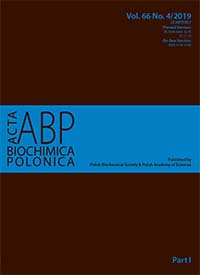Hydrogen sulfide formation in experimental model of acute pancreatitis
Abstract
Acute pancreatitis (AP) is a disease defined as acute or chronic inflammatory process of the pancreas characterized by premature activation of digestive enzymes within the pancreatic acinar cells and causing pancreatic auto-digestion. In mammalian tissues, H2S is synthesized endogenously from L-cysteine in regulated enzymatic pathways catalyzed by pyridoxal phosphate-dependent enzymes: cystathionine beta-synthase (CBS), gamma-cystathionase (CTH) and cysteine aminotransferase (CAT) coupled with 3-mercaptopyruvate sulfurtransferase (MPST). In the mitochondria, hydrogen sulfide is oxidized to sulfite, which is then converted to thiosulfate (a sulfane sulfur-containing compound) by thiosulfate sulfurtransferase (rhodanese; TST). Activity and expression of CBS, CTH, MPST, and TST have been determined in vivo in pancreas of the control rats, rats with acute pancreatitis and a sham group. Levels of low-molecular sulfur compounds, such as the reduced and oxidized glutathione, cysteine, cystine and cystathionine, were also determined. This study revealed a significant role of MPST in H2S metabolism in the pancreas. Stress caused by the surgery (sham group) and AP cause a decrease in H2S production associated with a decrease in MPST activity and expression. Markedly higher level of cysteine in the AP pancreas may be caused by a reduced rate of cysteine consumption in a reaction catalyzed by MPST, but it can also be a sign of proteolytic processes occurring in the changed tissue.
Acta Biochimica Polonica is an OpenAccess quarterly and publishes four issues a year. All contents are distributed under the Creative Commons Attribution-ShareAlike 4.0 International (CC BY 4.0) license. Everybody may use the content following terms: Attribution — You must give appropriate credit, provide a link to the license, and indicate if changes were made. You may do so in any reasonable manner, but not in any way that suggests the licensor endorses you or your use.
Copyright for all published papers © stays with the authors.
Copyright for the journal: © Polish Biochemical Society.


